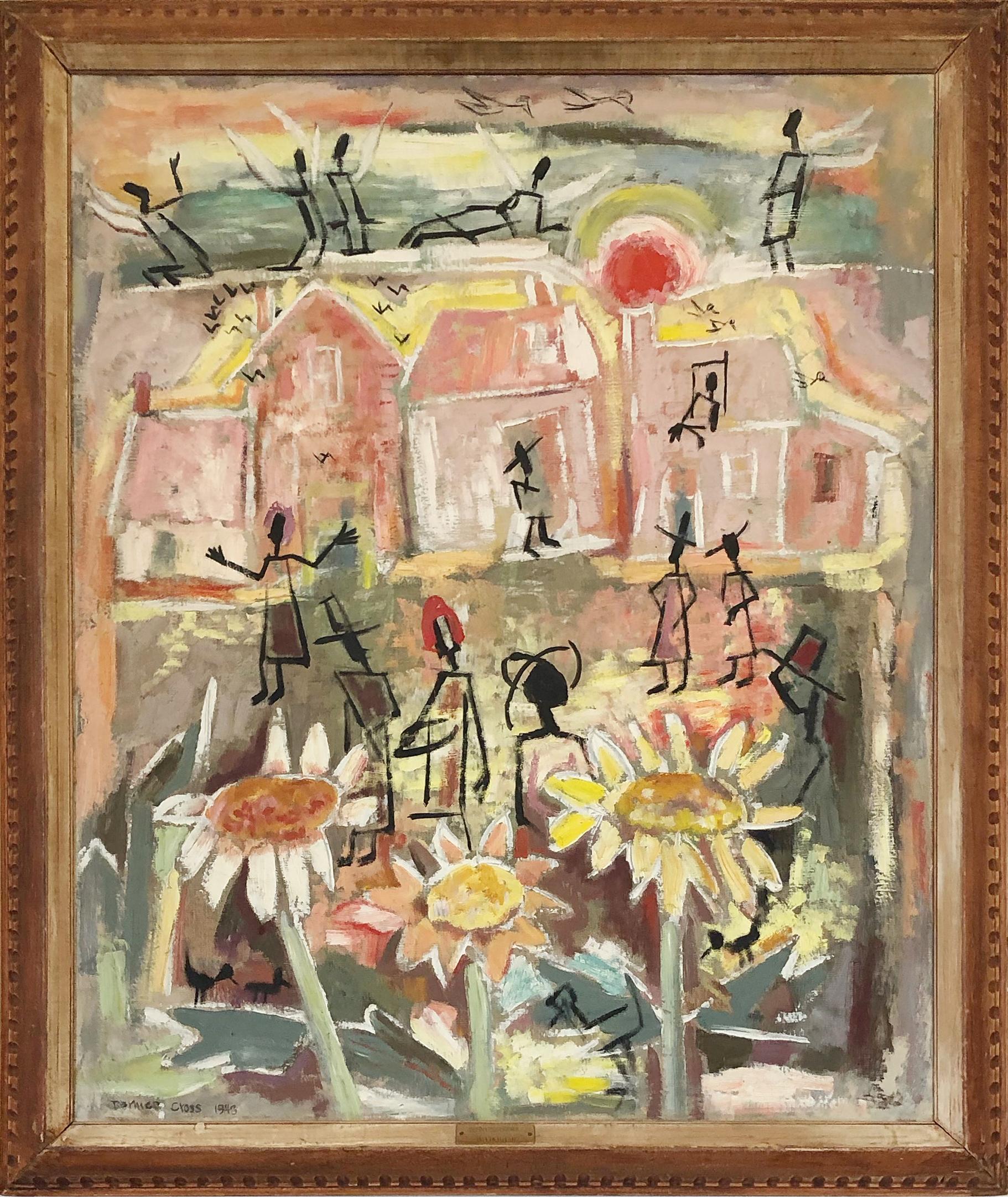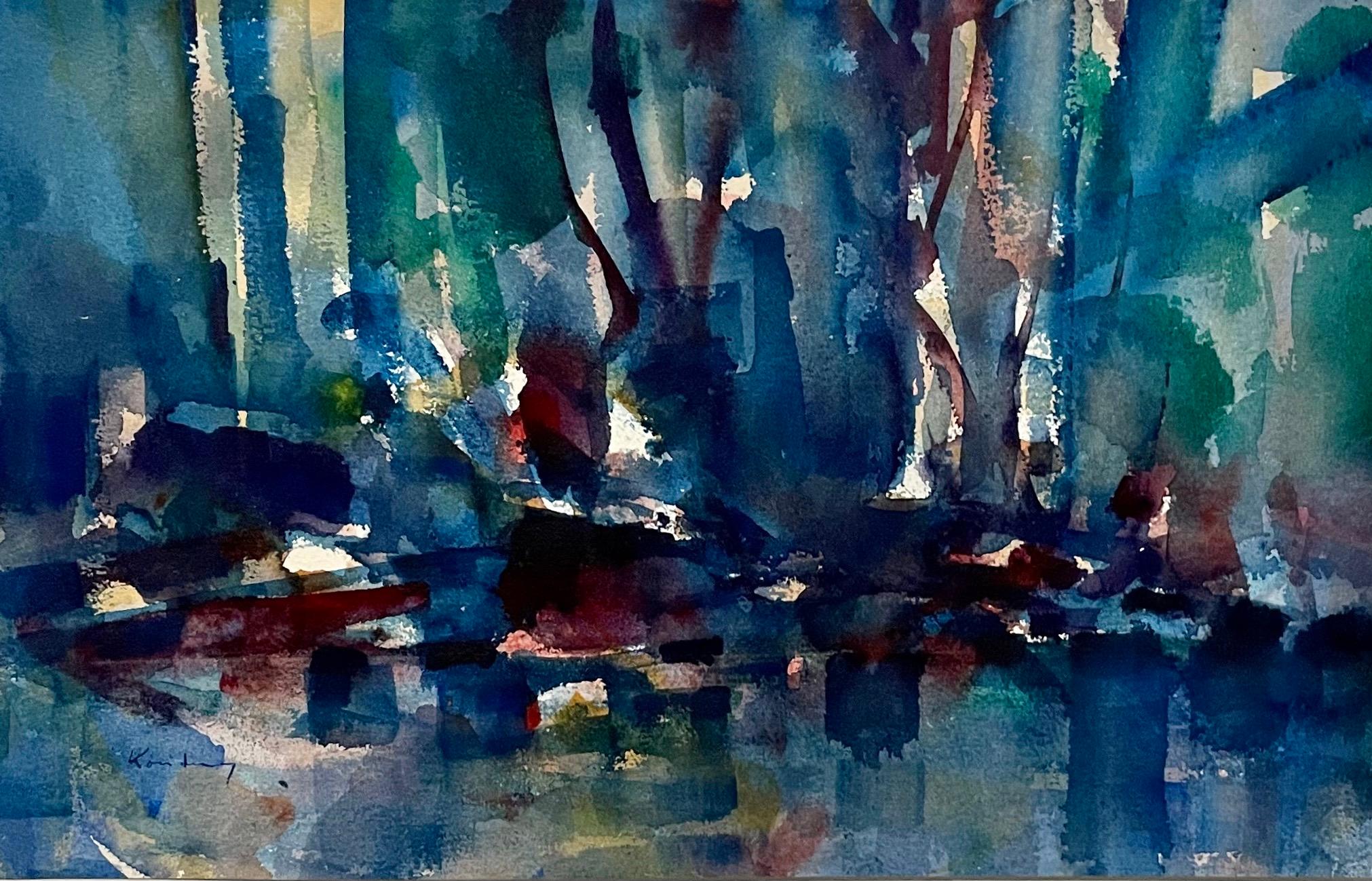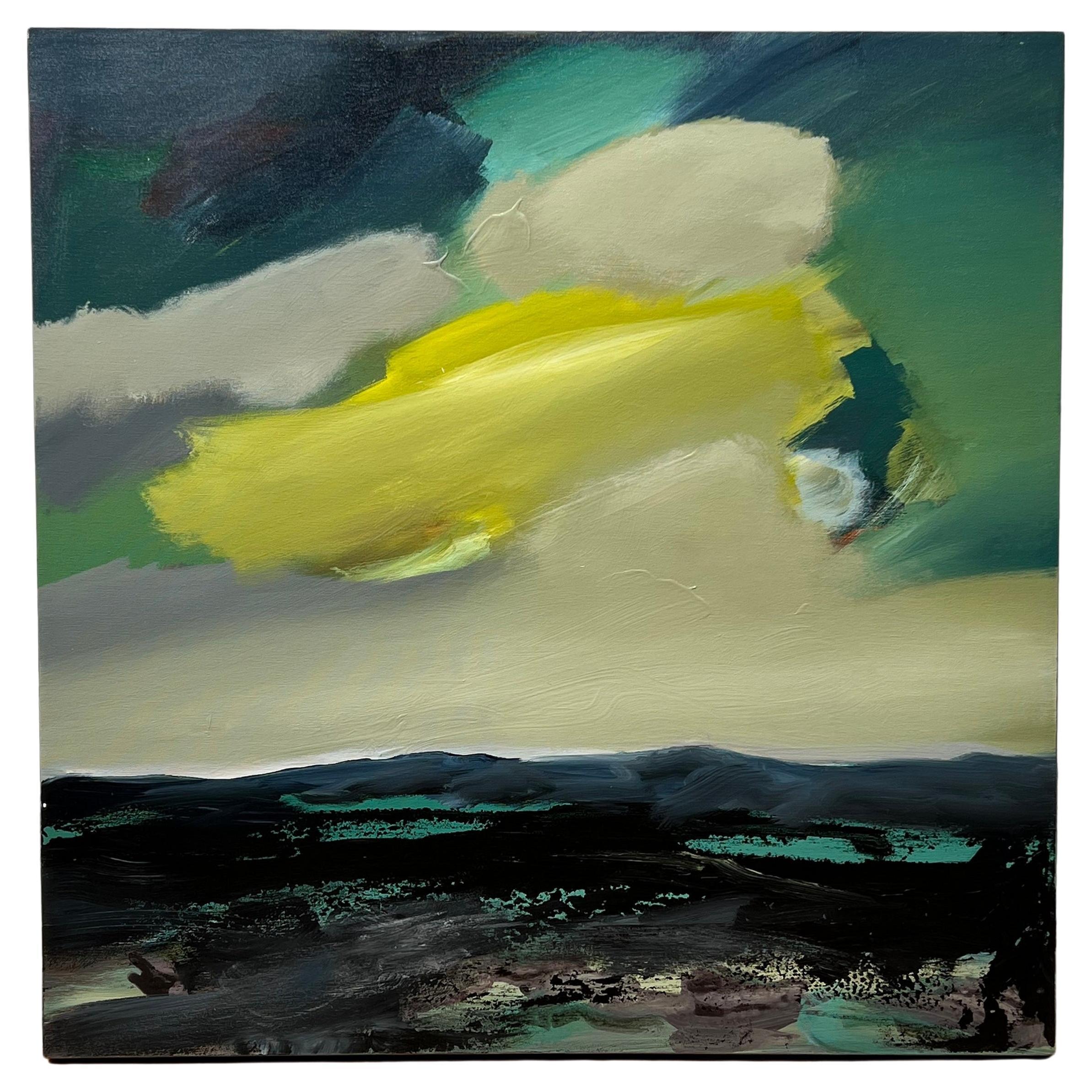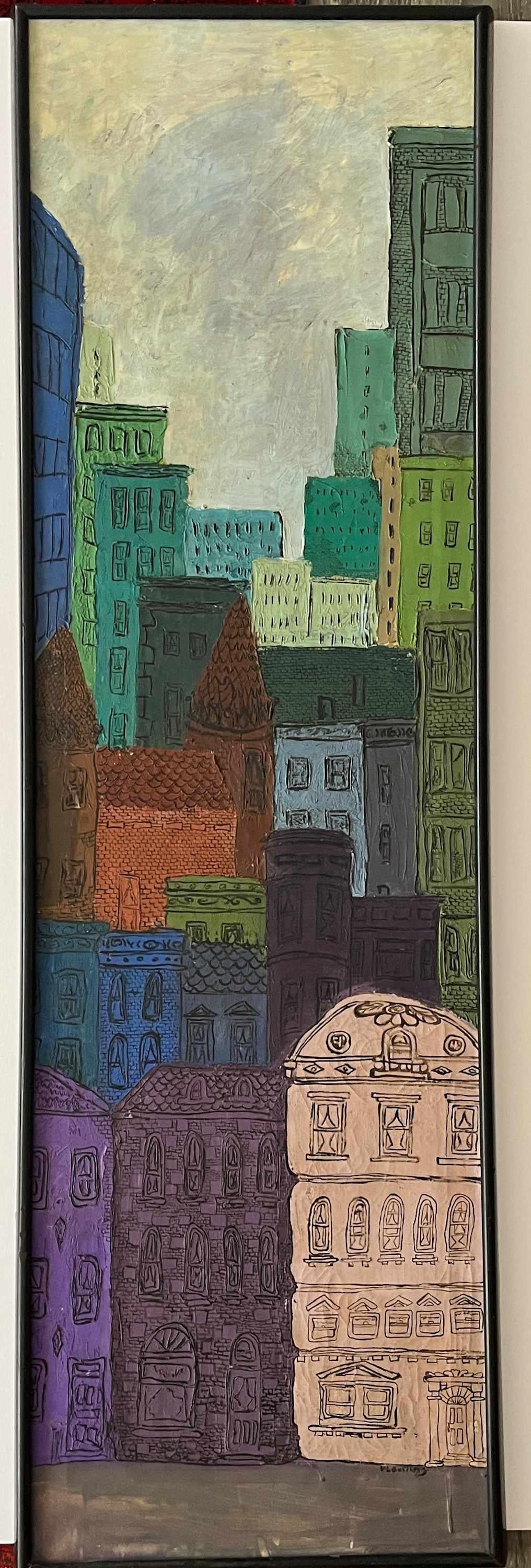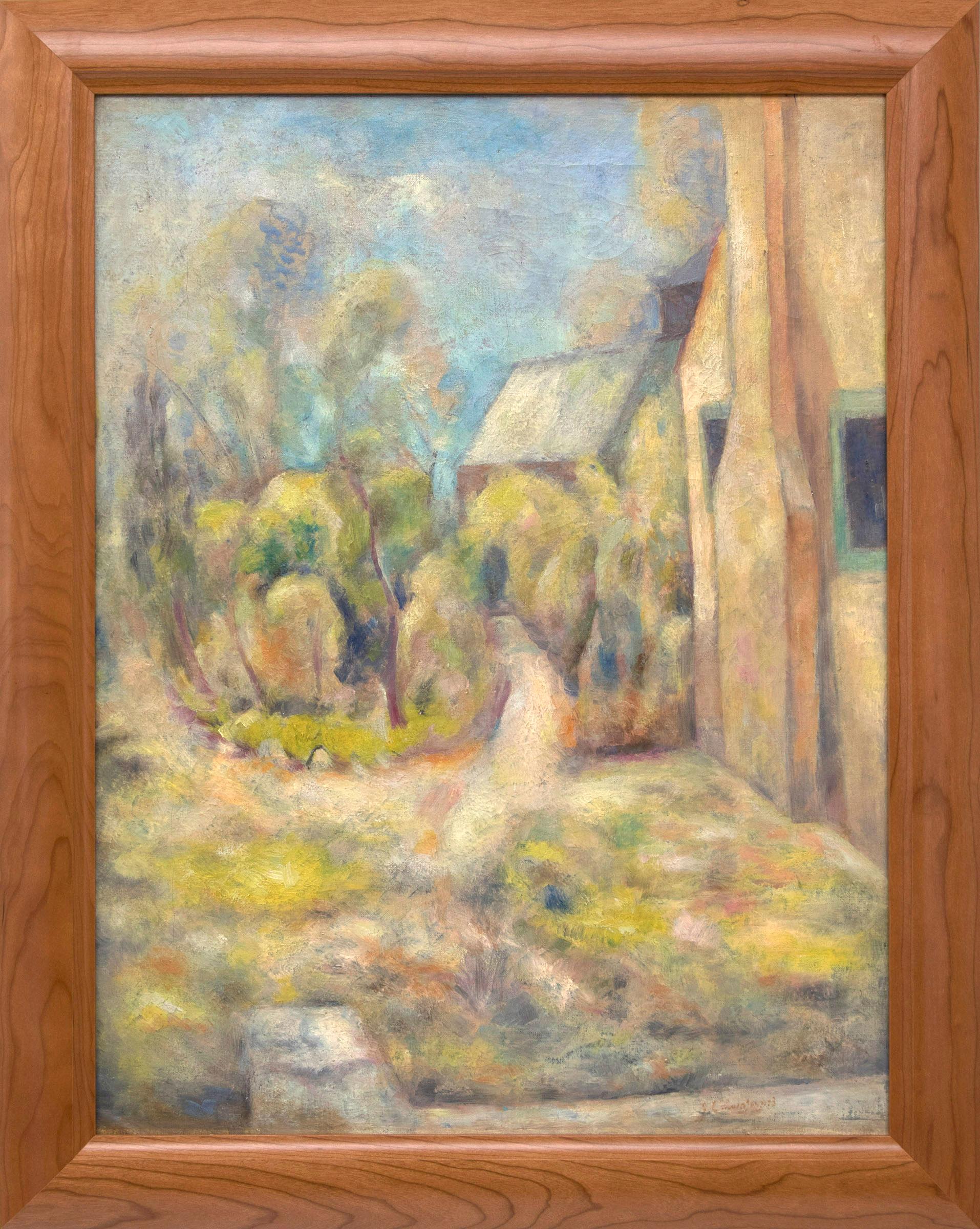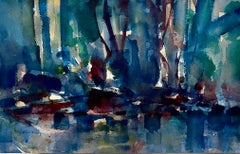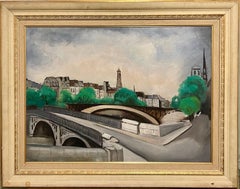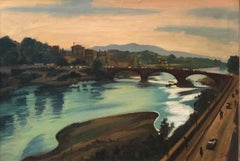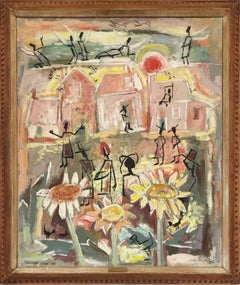Items Similar to Handmade Wool Tapestry Abstract American Modernist Arthur Dove Aubusson Style
Want more images or videos?
Request additional images or videos from the seller
1 of 15
(after) Arthur DoveHandmade Wool Tapestry Abstract American Modernist Arthur Dove Aubusson Style
About the Item
Original hand made, hand woven wall hanging modern art tapestry.
Manufactura de Tapecarias de Portalegre (Portugal) (TMP Fino) tapestries are woven by hand on vertical looms.
Arthur Garfield Dove (1880–1946) was an American artist. An early American modernist, he is often considered the first American abstract painter. Dove used a wide range of media, sometimes in unconventional combinations, to produce his abstractions and his abstract landscape painting. Dove did a series of experimental collage works in the 1920s. He also experimented with techniques, combining paints like hand mixed oil or tempera over a wax emulsion. Dove's childhood interests included playing the piano, painting lessons, and being a pitcher on a high school baseball team. Dove attended Hobart College and Cornell University, and graduated from Cornell in 1903. Dove was chosen to illustrate the Cornell University yearbook. Dove's illustrations proved popular because they brought life to the characters and situations they depicted. After graduation, he became a well known commercial illustrator in New York City, working for Harper's Magazine and The Saturday Evening Post. Dove's parents were upset at his choice to become an artist, instead of a more profitable profession that his Ivy League degree would have enabled, and they would prove unsympathetic to the difficulties that came with a career in art.
In 1907, Dove and his first wife, Florence, traveled to France and moved to Paris, then the world's art capital. They made short trips to both Italy and Spain. While there, Dove joined a group of experimental artists from the United States, which included Alfred Henry Maurer. While in Europe, Dove was introduced to new painting styles, in particular the Fauvist works of Henri Matisse, and he exhibited at the annual Autumn Salon in 1908 and 1909. When Dove returned to America in 1909 he met Alfred Stieglitz, a well known photographer and gallery owner who was very active in promoting modern art in America, including works by European artists that had never been seen before in the U.S. Dove exhibited his works at Stieglitz's 291 gallery in 1910 as part of the show "Younger American Painters", The show, which included a group of Dove's pastels that came to be known as "The Ten Commandments", was the first public exhibition of abstract art by an American.
Dove's most consistent supporter was Duncan Phillips, founder of the Phillips Collection in Washington, D.C., which now holds the majority of Dove's work. His work influenced later abstract landscape painters, such as Julian Hatton and Georgia O'Keeffe. His paintings would go on to have a major impact on the work of Abstract Expressionists such as Lee Krasner, Jackson Pollock, and Mark Rothko. The artist died on November 23, 1946 in Long Island, NY. Today, his works are held in the collections of the Art Institute of Chicago, The Museum of Modern Art in New York, and the National Gallery of Art in Washington, D.C., among others.
The Estate of Arthur Dove is represented by the Terry Dintenfass Gallery.
In 1946 Jean Cassou selected tapestry as the focus for the Musée national d’art moderne’s opening exhibition. Manufactura de Tapecarias de Portalegre (Portugal) (TMP Fino) tapestries are woven by hand on vertical looms. They are flat weave rug Aubusson style, woven from the base up and from the reverse side. The decorative weft wraps around the warp, crating a density of 2,500 stiches/dm2. Portalegre tapestries are limited series of 1, 4 or 8 tapestries based on the same original, each one numbered and hand-signed by the artist on the bolduc, a small cotton rectangle of fabric sewed on the back side of the tapestry. The bolduc also states the title, number and the dimensions of the tapestry. Many great modern artists such as Alexander Calder, Picasso, Vasarely have had their works translated into tapestries. Many Portuguese and foreign artists have had their work translated into Portalegre tapestries. They are the equivalent of the Belgian or French Aubusson Tapisserie Atelier such as Pinton Freres, Tabard, Goubely Gatien. They have worked with Jean Lurcat, Mathieu Mategot, Eduardo Nery, Graca Morais, Maria Vieira da Silva,
- Creator:(after) Arthur Dove (1880 - 1946)
- Dimensions:Height: 35.5 in (90.17 cm)Width: 60 in (152.4 cm)
- Medium:
- Movement & Style:
- Period:
- Condition:
- Gallery Location:Surfside, FL
- Reference Number:1stDibs: LU38215766672
About the Seller
4.9
Platinum Seller
Premium sellers with a 4.7+ rating and 24-hour response times
Established in 1995
1stDibs seller since 2014
1,742 sales on 1stDibs
Typical response time: 2 hours
- ShippingRetrieving quote...Shipping from: Surfside, FL
- Return Policy
Authenticity Guarantee
In the unlikely event there’s an issue with an item’s authenticity, contact us within 1 year for a full refund. DetailsMoney-Back Guarantee
If your item is not as described, is damaged in transit, or does not arrive, contact us within 7 days for a full refund. Details24-Hour Cancellation
You have a 24-hour grace period in which to reconsider your purchase, with no questions asked.Vetted Professional Sellers
Our world-class sellers must adhere to strict standards for service and quality, maintaining the integrity of our listings.Price-Match Guarantee
If you find that a seller listed the same item for a lower price elsewhere, we’ll match it.Trusted Global Delivery
Our best-in-class carrier network provides specialized shipping options worldwide, including custom delivery.More From This Seller
View AllModernist Abstract Expressionist Watercolor Painting Bauhaus Weimar Pawel Kontny
By Pawel Kontny
Located in Surfside, FL
Abstract watercolor composition bearing the influence of the earlier color-block compositions of Paul Klee.
Pawel August Kontny, (Polish-German-American artist) He was born in Laurahuette, Poland, in 1923, the son of a wealthy pastry shop owner. In 1939 he began studying architecture in Breslau where he was introduced to the European masters and to the work of some of the German Expressionists, soon afterward banned as "degenerate artists" and removed from museums throughout Germany by the Nazi regime. His studies were interrupted by World War II. Drafted into the German army, traveling in many countries as a soldier, he sketched various landscapes but in 1945, he was captured and held as a prisoner of war in Italy. After the war, he studied at the Union of Nuremberg Architects to help design buildings to replace ones destroyed in the war. He recorded his impressions of the local population and the landscapes through his watercolors and drawings. Pawel Kontny thereafter moved to Nuremberg, Germany, becoming a member of the Union of Nuremberg Architects and helping to rebuild the city's historic center. He soon decided to concentrate on his professional art career. He married Irmgard Laurer, a dancer with the Nuremberg Opera. Pavel Kontny 's career as an artist was launched with his participation in an all German exhibition, held at the Dusseldorf Museum in 1952. He held one-man shows in Germany, Switzerland and the United States. During his trip to the United States in 1960, Kontny became instantly enamored with Colorado, and decided to relocate to Cherry Hills with his wife and two children. He quickly established himself in the local art community, being affiliated for a time with Denver Art Galleries and Saks Galleries. His subject matter became the Southwest. During this time he received the Prestigious Gold Medal of the Art Academy of Rome. His extensive travel provided material for the paintings he did using his hallmark marble dust technique. he also worked equally in pastel, watercolor, charcoal and pencil-and-ink. in a style which merged abstraction and realist styles, influenced by Abstract Expressionist painting and South Western American landscapes. In the early 1960s he was one of only a few European-born professional artists in the state, a select group that included Herbert Bayer (1900-1985), a member of the prewar Bauhaus in Weimar and Dessau, Germany, and Roland Detre (1903-2001), a Hungarian modernist painter. As a Denver, Colorado resident, Pavel Kontny exhibited at galleries and museums throughout the United States, Germany and Japan. There, he was inspired by frequent trips to Native American pueblos in the Southwest, as well as by the study of the Plains Indians of Montana and Wyoming. Over the years Kontny had a number of students and generously helped young artist by hosting exhibitions at his Cherry Hills home. For many years he generously donated his paintings to support charitable causes in Denver. Influences during his European years included German pastelist C.O. Muller, German Informel painter Karl Dahmen and Swiss artist, Hans Erni. In the early 1950s his painting style showed the influence of the Die Brücke (The Bridge), a group of German expressionist artists formed in Dresden in 1905 who had a major impact on the evolution of modern art in the twentieth century in Germany. By the middle of the decade his style incorporated more referential abstraction and total abstraction, resulting in part from his study of Hans Hartung, a German artist based in Paris who exhibited his gestural abstract work in Germany. The American moon landing in 1969 inspired Paul Kontny...
Category
20th Century American Modern Landscape Paintings
Materials
Canvas, Oil
1927 Oil Painting Eiffel Tower Paris American Modernist Wpa Artist Morris Kantor
By Morris Kantor
Located in Surfside, FL
Morris Kantor New York (1896 - 1974)
Paris from the Ile St. Louis, 1927 (view of Eiffel Tower)
Oil painting on canvas
Hand Signed lower left.
Provenance: Hirshhorn Museum and Sculpture Garden, Smithsonian Institution ( bears label verso)
Size: 20 3/4"H x 28 1/8"W (sight), 28.75 "H x 36"W (framed)
Morris Kantor (Belarusian: Морыс Кантор) (1896-1974) was a Russian Empire-born American painter based in the New York City area.
Born in Minsk on April 15, 1896, Kantor was brought to the United States in 1906 at age 10, in order to join his father who had previously relocated to the states. He made his home in West Nyack, New York for much of his life, and died there in 1974. He produced a prolific and diverse body of work, much of it in the form of paintings, which is distinguished by its stylistic variety over his long career. Perhaps his most widely recognized work is the iconic painting "Baseball At Night", which depicts an early night baseball game played under artificial electric light. Although he is best known for his paintings executed in a realistic manner, over the course of his life he also spent time working in styles such as Cubism and Futurism, and produced a number of abstract or non-figural works. A famous cubist, Futurist, painting of his "Orchestra" brought over 500,000$ at Christie's auction house in 2018
Kantor found employment in the Garment District upon his arrival in New York City, and was not able to begin formal art studies until 1916, when he began courses at the now-defunct Independent School of Art. He studied landscape painting with Homer Boss (1882-1956). In 1928, after returning to New York City from a year in Paris, Kantor developed a style in which he combined Realism with Fantasy, often taking the streets of New York as his subject matter. He did some moody Surrealist Nude paintings and fantasy scenes. In the 1940's he turned towards figural studies. Later in his career, Kantor himself was an instructor at the Cooper Union and also at the Art Students League of New York in the 1940s, and taught many pupils who later became famous artists in their own right, such as Knox Martin, Robert Rauschenberg, Sigmund Abeles and Susan Weil...
Category
1920s American Modern Landscape Paintings
Materials
Canvas, Oil
Large Modernist Oil Painting Bridge over the Water Landscape
By Saul Schary
Located in Surfside, FL
Saul Schary was born in 1904 in Newark, New Jersey. Painter, Printmaker, Illustrator. He lived and worked in New York City and New Milford, Connecticut. Schary studied at the Art St...
Category
Mid-20th Century American Modern Landscape Paintings
Materials
Canvas, Oil
1930 Oil Painting Sea Side Sailboats American Modernist WPA Artist Morris Kantor
By Morris Kantor
Located in Surfside, FL
Morris Kantor, American, 1896-1974
Seaside View, 1930
Hand signed M. Kantor and dated 1930 lower right
Oil on canvas
22 1/4 x 19 1/4 inches
24 1/2 x 21 (frame)
Morris Kantor (Belarusian: Морыс Кантор) (1896-1974) was a Russian Empire-born American painter based in the New York City area. This is a beautiful boat scene with a river or lake probably on Long Island.
Born in Minsk on April 15, 1896, Kantor was brought to the United States in 1906 at age 10, in order to join his father who had previously relocated to the states. He made his home in West Nyack, New York for much of his life, and died there in 1974. He produced a prolific and diverse body of work, much of it in the form of paintings, which is distinguished by its stylistic variety over his long career. Perhaps his most widely recognized work is the iconic painting "Baseball At Night", which depicts an early night baseball game played under artificial electric light. Although he is best known for his paintings executed in a realistic manner, over the course of his life he also spent time working in styles such as Cubism and Futurism, (influenced by the Art Deco movement) and produced a number of abstract or non-figural works. A famous cubist, Futurist, painting of his "Orchestra" brought over 500,000$ at Christie's auction house in 2018. Kantor found employment in the Garment District upon his arrival in New York City, and was not able to begin formal art studies until 1916, when he began courses at the now-defunct Independent School of Art. He studied landscape painting with Homer Boss (1882-1956). In 1928, after returning to New York City from a year in Paris, Kantor developed a style in which he combined Realism with Fantasy, often taking the streets of New York as his subject matter. He did some moody Surrealist Nude paintings and fantasy scenes. In the 1940's he turned towards figural studies. Later in his career, Kantor himself was an instructor at the Cooper Union and also at the Art Students League of New York in the 1940s, and taught many pupils who later became famous artists in their own right, such as Knox Martin, Robert Rauschenberg, Sigmund Abeles and Susan Weil...
Category
1930s American Modern Landscape Paintings
Materials
Canvas, Oil
Large Modernist Abstract Expressionist Gouache Painting Bauhaus Weimar Artist
By Pawel Kontny
Located in Surfside, FL
Abstract watercolor or gouache composition bearing the influence of the earlier color-block compositions of Paul Klee.
Pawel August Kontny, (Polish-German-American artist) He was born in Laurahuette, Poland, in 1923, the son of a wealthy pastry shop owner. In 1939 he began studying architecture in Breslau where he was introduced to the European masters and to the work of some of the German Expressionists, soon afterward banned as "degenerate artists" and removed from museums throughout Germany by the Nazi regime. His studies were interrupted by World War II. Drafted into the German army, traveling in many countries as a soldier, he sketched various landscapes but in 1945, he was captured and held as a prisoner of war in Italy. After the war, he studied at the Union of Nuremberg Architects to help design buildings to replace ones destroyed in the war. He recorded his impressions of the local population and the landscapes through his watercolors and drawings. Pawel Kontny thereafter moved to Nuremberg, Germany, becoming a member of the Union of Nuremberg Architects and helping to rebuild the city's historic center. He soon decided to concentrate on his professional art career. He married Irmgard Laurer, a dancer with the Nuremberg Opera. Pavel Kontny 's career as an artist was launched with his participation in an all German exhibition, held at the Dusseldorf Museum in 1952. He held one-man shows in Germany, Switzerland and the United States. During his trip to the United States in 1960, Kontny became instantly enamored with Colorado, and decided to relocate to Cherry Hills with his wife and two children. He quickly established himself in the local art community, being affiliated for a time with Denver Art Galleries and Saks Galleries. His subject matter became the Southwest. During this time he received the Prestigious Gold Medal of the Art Academy of Rome. His extensive travel provided material for the paintings he did using his hallmark marble dust technique. he also worked equally in pastel, watercolor, charcoal and pencil-and-ink. in a style which merged abstraction and realist styles, influenced by Abstract Expressionist painting and South Western American landscapes. In the early 1960s he was one of only a few European-born professional artists in the state, a select group that included Herbert Bayer (1900-1985), a member of the prewar Bauhaus in Weimar and Dessau, Germany, and Roland Detre (1903-2001), a Hungarian modernist painter. As a Denver, Colorado resident, Pavel Kontny exhibited at galleries and museums throughout the United States, Germany and Japan. There, he was inspired by frequent trips to Native American pueblos in the Southwest, as well as by the study of the Plains Indians of Montana and Wyoming. Over the years Kontny had a number of students and generously helped young artist by hosting exhibitions at his Cherry Hills home. For many years he generously donated his paintings to support charitable causes in Denver. Influences during his European years included German pastelist C.O. Muller, German Informel painter Karl Dahmen and Swiss artist, Hans Erni. In the early 1950s his painting style showed the influence of the Die Brücke (The Bridge), a group of German expressionist artists formed in Dresden in 1905 who had a major impact on the evolution of modern art in the twentieth century in Germany. By the middle of the decade his style incorporated more referential abstraction and total abstraction, resulting in part from his study of Hans Hartung, a German artist based in Paris who exhibited his gestural abstract work in Germany. The American moon landing in 1969 inspired Paul Kontny...
Category
20th Century American Modern Landscape Paintings
Materials
Watercolor, Archival Paper
Modernist Impasto Painting Mountain with Ocean Landscape J. James Akston
Located in Surfside, FL
J. James Akston
Mountain Landscape by ocean
Acrylic on Board
Frame: 11.5 x 16.
Image: 5 X 9.5
Joseph James Akston was a Polish American sculptor, painter, known for surrealist abstract painting and Aubusson (for Les Ateliers Pinton Frères, tapisserie, Aubusson) tapestry artist. Born in Warsaw, Poland in 1898 he died in Palm Beach Florida in 1983. During the 1960s and '70s the entrepreneur-artist James Joseph Akston adopted a unique Surreal Expressionist style in order to present his private primordial universe and lampoon its denizens, a ribald cast of animal creatures with human foibles. A successful industrialist, he began his career with General Motors foreign operations and then started his own business.
Intermittently he studied painting, first with Jerry Farnsworth in North Truro (Mass.) and then with Jose Clemente Orozco in Mexico. In the early 1960s Akston became publisher-editor of a group of art publications which included The Magazine Arts. Initially an abstract expressionist, Akston had one-man exhibitions at the New York Convention Center and the Corcoran Museum in Washington. Since 2015 the record price for this artist at auction is $12,575 USD for Spheres Aux Triangles Aubusson Tapestry, sold at Bonhams New York in 2019.
He was a Graduate of Georgetown University. He sat on the board of the Norton Museum.
Exhibitions
1976 Hokin Gallery
1966 Gallery 63 NYC
1960 Gallery 63 Rome , Italy
Select Public Collections
National Museum, Wshington DC
Boca Museum of Art
Whitney Museum of Art, NYC
Museum of Modern Art, NYC
Museum of African Art Washington DC (Now part of Smithsonian Museum)
Bibliography: 1962 Art...
Category
Mid-20th Century American Modern Landscape Paintings
Materials
Oil
You May Also Like
Missouri American Modernist famous in Europe - abstracted mid century Venice
Located in Norwich, GB
Meet the genuinely exciting modernist William Einstein, who is probably better known in Europe, where numerous publications on his work have been written, than in his native US!
Eins...
Category
1950s American Modern Landscape Paintings
Materials
Canvas, Oil
Halleluja, A story
Located in Greenwich, CT
Initially read as archaic and simple, Halleluja is a complex celebratory spring painting full of color, imagination, and humor and combines many elements seen throughout her later ca...
Category
1940s American Modern Figurative Paintings
Materials
Oil, Canvas
"Yellow Sky" Oil on Canvas by Jerome Gastaldi #2
Located in Pasadena, CA
This painting features a yellow sky (as Gastaldi named it) and it is part of 3. The #1 one is featuring a red sky and the third one is the desert light.
#1 and 2 show the strength of nature with vigorous large brush strokes and bright colors whereas the colors of #3 depicting the desert light, are more muted and reflect perfectly the desert atmosphere before a storm.
See, attached the pictures of the 2 matching ones.
Jerome Gastaldi, born in Oakland, California, in 1945, is a contemporary artist.
His works have been compared by art critics to that of Robert Rauschenberg, Edward Kienholz...
Category
21st Century and Contemporary American Modern Landscape Paintings
Materials
Canvas, Oil
$1,920 Sale Price
20% Off
"Victorians" Impasto Oil Landscape Painting 20th Century
Located in Arp, TX
Unidentifiable signature
"Victorians"
c. 1960s
Oil impasto paint on canvas
17.5"x60" black period wood frame 18.25"x61.25"
Signed in paint lower right
Category
Mid-20th Century American Modern Landscape Paintings
Materials
Canvas, Oil
$1,125 Sale Price
25% Off
Early Spring, 1930s Impressionist Style Oil Painting of Artist’s Studio Exterior
By John Edward Thompson
Located in Denver, CO
This original oil on canvas painting, titled Early Spring (Thompson's Studio), was created in 1933 by renowned Colorado modernist John Edward Thompson (1882-1945). A striking example...
Category
1930s American Modern Landscape Paintings
Materials
Canvas, Oil
“Bouquet by the Sea”
By Nicolai Cikovsky
Located in Southampton, NY
Oil on artist board original painting by the well known American artist, Nicolai Cikovsky. Thick vibrant colors with a vase of flowers, a banjo and a notebook with photographs with a rough sea as the background. Circa 1940. Condition is very good.
Overall framed in a circa 1960 frame, 23 by 27.25 inches.
Landscape and figure painter Nicolai S. Cikovsky, 1894-1984, was born in Russia, where he studied at the Vilna Art School, 1910-1914; the Penza Royal Art School, 1914-1918; and Moscow High Tech Art...
Category
1940s American Modern Landscape Paintings
Materials
Canvas, Oil, Board
$4,800 Sale Price
20% Off
Recently Viewed
View AllMore Ways To Browse
Landscape Rug
French Dove
Weaving Hanging Art
Dior Vertical
Modernist Tapestry
Vintage Italian Tapestry Tapestries
Picasso Tapestry
Picasso A Trip To Paris
Terry Paris
Henri Matisse S
Picasso Dover
Tapestry Looms Used
Original Painting Doves
Aubusson Fabric
Alexander Calder Hand Signed
After Picasso Tapestry
Tapestry Autumn
Henri Matisse Original Hand Signed
